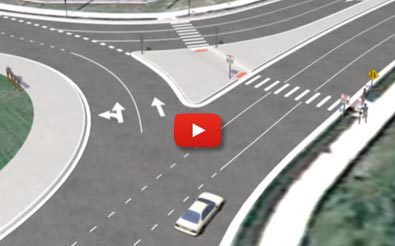December 27, 2013
Innovation Implementation: Intersection and Interchange Geometrics
Intersection and interchange geometrics use proven techniques to accommodate traffic volumes more efficiently while enhancing safety for road users. The Federal Highway Administration recommends that agencies consider roundabouts, displaced left turn intersections, U-turn intersections and diverging diamond interchanges when planning intersection construction projects.
The modern roundabout is a circular intersection in which traffic travels counterclockwise around a central island and entering traffic yields to circulating traffic. It improves safety by replacing perpendicular crossings and opposing direction turns with low-speed merging and diverging maneuvers. Mini-roundabouts with a fully traversable central island can be used at locations with constrained right-of-way.
 Video demonstrates the proper use of a roundabout, whether you are a motorist, bicyclist or pedestrian. See Video
Video demonstrates the proper use of a roundabout, whether you are a motorist, bicyclist or pedestrian. See Video
Many agencies are building roundabouts to reduce crashes. The Connecticut Department of Transportation, for example, converted a rotary at Routes 80 and 81 in Killingworth to a roundabout, which resulted in a 50 percent drop in the number of crashes at the site and a National Roadway Safety Award. The Maine Department of Transportation included two roundabouts in an I-95 interchange improvement project near a new hospital in Augusta to minimize congestion and enhance safety.
The Michigan Department of Transportation video below shows motorists how to use a roundabout.
Bridge Group Explores GRS-IBS
FHWA staff provided an overview of geosynthetic reinforced soil integrated bridge system technology at a Short Span Steel Bridge Alliance Substructures Working Group meeting on December 4. The group includes bridge and culvert industry leaders who provide educational information on the design and construction of short span steel bridges up to 140 feet long. The group requested the GRS-IBS presentation to learn more about this option as it develops a substructures section for its eSPAN140 design tool, which provides customized steel solutions for bridges. As a result, it plans to feature the GRS-IBS as one of four suggested technologies in eSPAN140’s Solutions Book and include details on the technology on its website.
Design-Build Contract Signed for Florida Project
The Tampa-Hillsborough Expressway Authority received a $10.9 million TIGER grant to finish construction along the 2.6-mile Tampa Riverwalk and build a 1.7 mile multiuse trail called the Selmon Greenway. The authority executed the design-build contract on December 10 to move the Selmon Greenway phase of the project forward. Project completion is set for late 2015. Project benefits include increased pedestrian safety, decreased traffic congestion and improved accessibility to the city’s transit system of buses, trolleys, streetcars and water transports.
Indiana Pursues In-Lieu Fee Program
Representatives of the U.S. Army Corps of Engineers, Indiana Department of Environmental Management, Indiana Department of Natural Resources, Indiana Department of Transportation and FHWA met November 22 to discuss an in-lieu fee program in Indiana. FHWA funds are being used to help develop the statewide program, which will expedite the permitting process for transportation construction projects in Indiana. Ducks Unlimited has been selected to develop the process over the next 16 months.
Indiana Rolls Out Intersection Design Guide
The Indiana DOT is implementing a process to provide guidance on selecting the best intersection to build at a particular location. Options include nine different types, including alternative intersection designs. An agency technical working group developed an Intersection Design Guide with input from FHWA, and 45 engineers who make decisions on intersection design participated in training in December. A companion guide to interchange designs is in the works.
Maine Considers Programmatic Agreement
The Maine Department of Transportation, along with the U.S. Fish and Wildlife Service, National Marine Fisheries Service, U.S. Army Corps of Engineers and FHWA, met December 16 to discuss developing a programmatic consultation agreement to address the effects of transportation projects on Atlantic salmon. The agreement will ultimately streamline the consultation process required for Maine DOT projects under Section 7 of the Endangered Species Act. The target date to have the agreement in place is the end of 2014.
Oklahoma Tries High-Friction Surface Treatment
The Oklahoma Department of Transportation successfully installed the state’s first high-friction surface treatment on December 17. The project involved one of the two most dangerous curves on State Highway 20 north of Salina. The second installation will be done when weather conditions permit. The long-lasting high-traction surface treatment was chosen to reduce crashes, injuries and fatalities. On hand for the installation were representatives from the Oklahoma DOT, FHWA, American Traffic Safety Services Association, local contractors, consultants and a contractor from Mexico.
Texas Bridge Project Ahead of Schedule
The Texas Department of Transportation and FHWA approved the U.S. 181 Harbor Bridge draft environmental impact statement on December 16, nine months earlier than scheduled. The combined Every Day Counts processes of enhanced technical assistance on projects requiring environmental impact statements and legal sufficiency enhancements helped complete the draft statement just two-and-a-half years after the June 2011 notice of intent. The Texas DOT and FHWA plan to initiate design-build procurement for the project in early 2014 and deliver a combined final environmental impact statement and record of decision in Fall 2014, two years earlier than expected.


